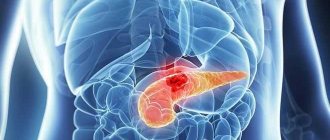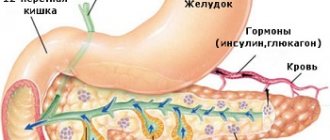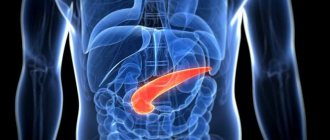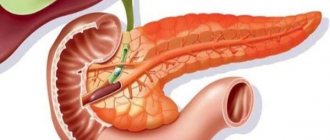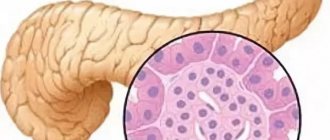The pancreas in its normal state is a pyramid-shaped organ with a homogeneous structure. Only in this case does the gland work correctly and produce insulin and enzyme juices, thanks to which food is digested and absorbed.
But it also happens to observe deviations in the functioning of this organ associated with its density. Heterogeneous structure of the pancreas, what is it and what does it mean for humans?
The quality of the pancreas can only be determined through a complete diagnosis, including ultrasound examination. Any changes in the structure may indicate the onset of problems and serious disruptions in the functioning of the internal secretion organ.
Causes of the heterogeneous structure of glandular tissue
The change in the density of glandular tissue is influenced by many factors, sometimes they even act together in tandem:
- Systematic poor nutrition. The state of the gastrointestinal tract directly depends on the quality of nutrition. Constant consumption of unhealthy foods can cause digestive disorders and inflammatory processes, which lead to changes in the digestive and auxiliary systems.
- Previous operations on the gastric tract. Surgical intervention entails a temporary exit from the usual rhythm of many systems. With improper rehabilitation measures or during severe operations, a diffusely heterogeneous structure of the pancreas is observed.
- Development of pancreatitis. This factor more often than others causes the structure of the pancreas to become heterogeneous. The inflammatory process at different stages can lead to irreversible consequences with glandular tissue.
- Diabetes. Damage to the tail of the pancreas provokes a deficiency of insulin in the blood, which causes a dangerous disease called diabetes mellitus. If the pathology is not treated in a timely manner, a disturbed echostructure of the pancreas is observed.
- Nervous shocks. For the most part, all ailments begin to arise under favorable conditions, when the human body experiences shock and panic. It is during nervous situations that a person will experience internal unrest, which negatively affects the body’s immune and defense systems; it is at this moment that diseases worsen and new pathologies arise.
The structure of the pancreas: anatomy
We will consider the pancreas, its purpose in the human body, what are the structural features, anatomy and functions of the pancreas in detail in our review.
The pancreas is an organ in the abdominal cavity and is the largest gland in the body. It belongs to the glands of mixed secretion. Question: What does the pancreas produce? The organ secretes pancreatic juice, rich in enzymes and hormones responsible for carbohydrate-protein metabolism.
Anatomy of the human pancreas
The structure of the human pancreas is represented by a lobed, comma-shaped organ of gray-pink color. It is located behind and slightly to the left of the stomach. If a person is placed on his back, this organ will be under the stomach, based on this, the name “pancreas” appeared. The body, head and tail of the pancreas are distinguished.
The head of the pancreas is the part of the organ that directly adjoins the duodenum. At the border of the body and head there is a recess in which the portal vein runs. The body of the pancreas has the shape of a triangular prism.
The front part is directed towards the back wall of the stomach and slightly upward. Posterior - to the spine, it is in contact with the inferior vena cava, abdominal aorta, and celiac plexus.
The lower surface is directed downward and slightly forward, located slightly below the mesentery of the colon.
The tail of the gland is pear-shaped and runs towards the hilum of the spleen.
The duct of Wirsung runs throughout the gland, flowing into the duodenum.
Features of the structure of the pancreas.
The pancreas is well supplied with blood; it is nourished simultaneously by several sources. The branches of the superior and inferior pancreaticoduodenal arteries approach the head, the body and tail receive nutrition from the branches of the splenic artery.
The outflow of blood occurs through the pancreaticoduodenal vein, which is part of the portal vein system.
Innervation of the pancreas
On the part of the parasympathetic nervous system, the gland is innervated by the vagus nerve, while the sympathetic nervous system is innervated by the celiac plexuses.
Histological structure of the human pancreas
In terms of its structure, the pancreas is a rather complex alveolar-tubular organ. The main substance that makes up the gland is divided into small segments. Between the lobules there are vessels, nerves and small ducts that collect secretions and deliver them to the main duct. According to its structure, the pancreas can be divided into two parts: endocrine and exocrine
The part of the pancreas responsible for exocrine function consists of acini, which are located in lobules. Ducts depart from the acini in a tree-like form: intralobular ducts flow into interlobular ducts, then into the main pancreatic duct, which opens into the lumen of the duodenum.
The islets of Langerhans are responsible for endocrine function. They usually have a spherical shape and consist of insulocytes. Depending on their function and morphological abilities, insulocytes are divided into β-cells, α-cells, Δ-cells, D-cells, PP-cells.
Functions of the pancreas
The functional abilities of the pancreas are divided into two groups:
- Exocrine abilities consist in the secretion of pancreatic juice, rich in enzymes involved in the digestion of food. The main enzymes produced by the pancreas are amylase, lipase, trypsin and chymotrypsin. The last two are activated in the duodenum under the action of enterokinase.
- Endocrine abilities involve the release of hormones involved in carbohydrate metabolism. The main hormones that the pancreas secretes are insulin and glucagon. These two hormones are completely opposite in their action. Also, the pancreas produces neuropeptide hormone, pancreatic polypeptide and somatostatin.
Pancreatic diseases
Among the diseases of the pancreas are:
- Acute pancreatitis. The cause of this disease is hyperstimulation of the secretory function of the gland with obstruction of the ampulla of the duodenal papilla. Pancreatic juice is released, but its outflow into the duodenum is disrupted, and enzymes begin to digest the gland itself. The parenchyma of the pancreas increases and begins to put pressure on the capsule. Since this organ is well innervated and supplied with blood, inflammation develops at lightning speed and the pain syndrome is very pronounced. The patient feels severe pain in the epigastrium, often of a girdling nature. If you do not seek help in time, pancreatic necrosis with peritonitis may develop. The cause of acute pancreatitis may be alcohol intoxication, consumption of junk food, or the presence of cholelithiasis in the patient.
- Chronic pancreatitis. There are several forms of chronic pancreatitis:
-primary, the cause may be the use of alcohol, medications, poor diet, metabolic disorders in the body;
- secondary, occurs due to other diseases in the body;
- post-traumatic pancreatitis, occurs due to injuries or after endoscopic examinations.
Chronic pancreatitis is manifested by insufficiency of the pancreas to secrete enzymes. An ultrasound will show changes in the structure of the pancreas; sclerosis of the ducts and the formation of stones in them (calculous pancreatitis) are possible. The consequences of chronic pancreatitis can be disruption of the functioning of all systems, this directly concerns the digestive and endocrine systems.
- Pancreatic cysts can be congenital or acquired. Acquired cysts are caused by trauma, acute and chronic pancreatitis. Separately, parasitic cysts can be distinguished; in most cases, their cause is echinococcal infection.
- Pancreatic tumors are divided into hormonally active and hormonally inactive. Hormonally active ones include glucogenoma, insulinoma and gastrinoma. These tumors are very difficult to diagnose; they are often detected when a concomitant disease (diabetes mellitus) is diagnosed. Pancreatic cancer is classified as hormonally inactive. This tumor can cause discomfort in the epigastric region, dyspeptic disorders, and sudden weight loss. If the tumor is located in the head of the pancreas, the patient may have obstructive jaundice. Treatment of tumors is only surgical.
Diseases associated with echogenic, heterogeneous and compacted structure of the pancreas
Heterogeneous structure of the pancreas, what is it? A healthy gland must have a structure with homogeneous areas, only then is it a completely healthy organ that functions correctly.
But there are exceptions when, during long-term diseases, the structure becomes homogeneous, but at the same time echogenicity or compaction increases - this is also a serious deviation from the norm, which requires urgent therapeutic action. We will consider below what diseases are associated with changes in pancreatic tissue.
Pre-acute stage of pancreatitis
It is the condition that foreshadows the imminent onset of a relapse of the disease that is negatively reflected in the diagnostic data of gland density.
With timely diagnosis of this condition, it is possible to restore tissue with the help of drug treatment and avoid worsening the disease. This period does not last long, so it is necessary to contact specialists at the first incomprehensible signs of the disease. Only an echogram and ultrasound will be able to recognize the problem at an early stage.
Chronic form of pancreatitis
With chronic manifestations of inflammation of the pancreas, the disease can only be recognized in the active stage, passing into a state of remission; the disease is not reflected in any way on the gland, and its condition is difficult to determine using an echogram and ultrasound examination.
Cysts
A cyst is a formation on the tissue of the gland, which during diagnosis is visible as small compactions. They can move from time to time, so you need to monitor their development and take measures to eliminate them;
Tumors
Another type of neoplasm that, upon examination, shows uneven structure of the pancreas. Tumors must be treated with special care, because not all of them are benign, and some change from benign to malignant. With an echogram, malignant tumors absorb more sound, so they can be preliminarily recognized at the diagnostic stage.
Diet for diffuse changes in the parenchyma
If diffuse disorders are detected in the parenchymal tissues, the patient is prescribed a diet. Its choice depends on the nature of the pathology that led to the appearance of such changes.
If you have diabetes, it is recommended to completely eliminate sugar and sweet fruits from your diet. Alcohol, spicy, fatty, salty, fried and smoked foods, canned food, sausages, carbonated drinks, seasonings and packaged juices are excluded from the menu. The daily diet is allowed to include lean meat and fish, cereals, dairy products, vegetables and unsweetened fruits. Nutrition should be adjusted depending on glucose levels.
If diseases of the pancreas and gastrointestinal tract are detected, the patient is recommended to follow a diet that is indicated for the pathology of a particular organ. In such cases, dry food and overeating are strictly prohibited. Food should be steamed, boiled or baked and taken in small portions, 4-5 times a day.
Experience - 21 years. I'm writing a stat
How to treat a heterogeneous structure of the pancreas
First of all, in order to detect problems with the density of glandular tissue, you need to undergo a full examination by specialists in a timely manner. For people who have previously had problems with digestion and the gastrointestinal tract, examination should be carried out at least once a year.
After diagnosing the disease, you need to go to a gastroenterologist with the results, and if insulin deficiency develops, to an endocrinologist. Only the attending physician selects treatment. Basically, the structure of the gland is restored with the help of medications. In particular, they take medications for pancreatitis. Treatment will be effective if it is carried out against the background of proper nutrition. Diet is important for gland diseases. They create a menu together with the attending physician, taking into account the characteristics of the patient’s body and the situation with the disease.
Surgery is performed extremely rarely, mainly to remove tumors that could not be eliminated with drug treatment. But this is more the exception than the rule.
If you follow all the doctor’s instructions and carefully follow your diet, you can safely return the gland to its normal shape and structure.
